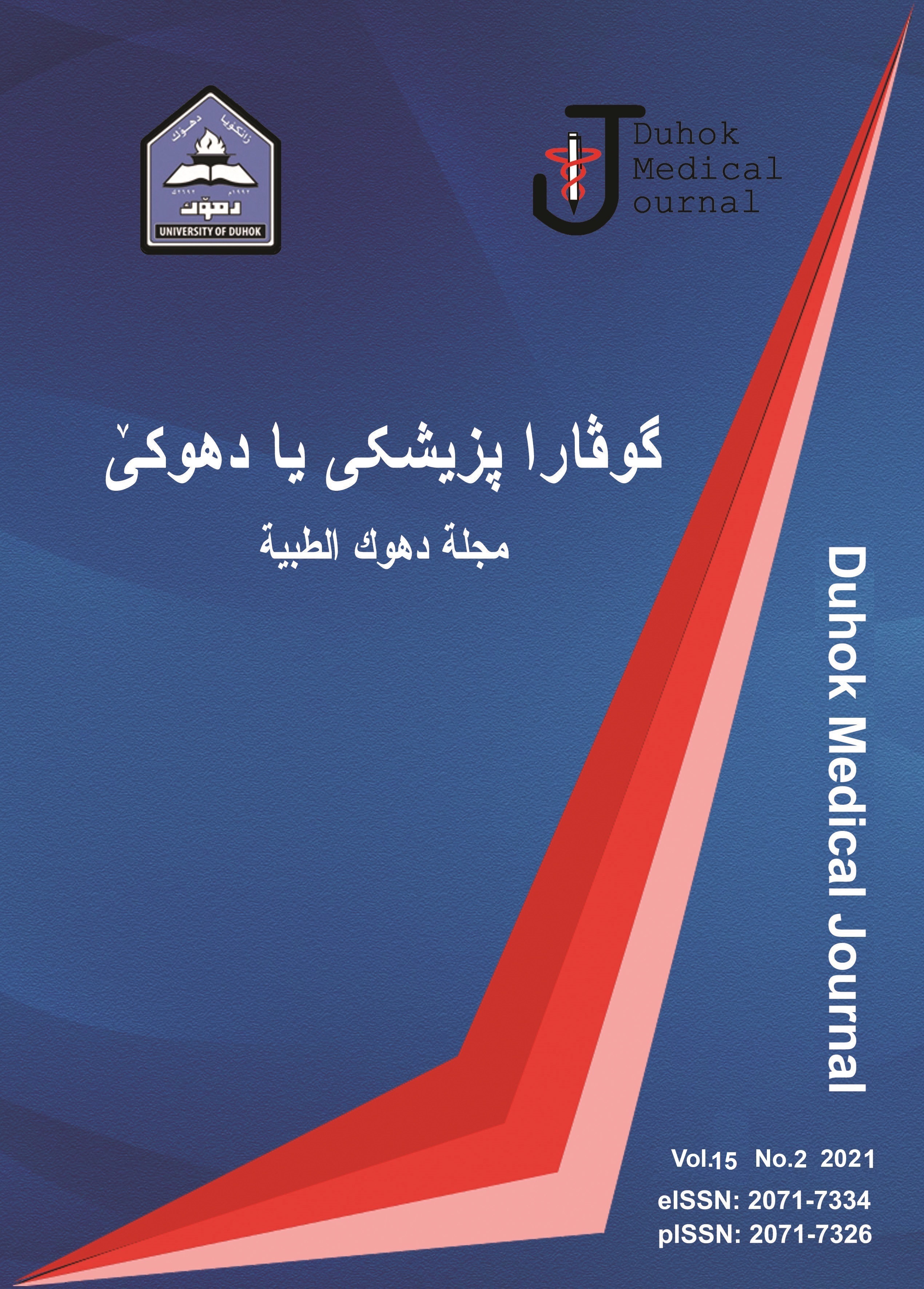SEROSURVEY OF ANTI-TOXOCARA ANTIBODIES AND RISK FACTORS IN RELATION TO VITAMIN D LEVELS AMONG PREGNANT WOMEN OF DUHOK CITY –KURDISTAN REGION
Abstract
https://doi.org/10.31386/dmj.2021.15.2.5
Background: Toxocariasis is a common parasitic disease which is caused by Toxocara Spp. with a worldwide distribution, which causes visceral larval migrans as loss of vision, hypereosinophilia, encephalitis, hepatomegaly, and lungs damage.
Materials and Methods: The blood samples were collected randomly from 150 pregnant women attending maternity hospital in Duhok city, Kurdistan Region. A special questionnaire form is arranged for each woman including the following information’s (age, residency, occupation, family income, paternity, contact with cats, presence of domestic cats and dogs, working in home garden, source of drinking water, washing hands before meals, consumption of raw meat).
The blood was used to investigate the blood parameters as (WBCs, lymphocytes, RBCs, Hb., HCT, PCV, and Platelets) on the other hand, in other tubes, the blood was centrifuged to obtain sera for the detection of both anti-Toxocara antibodies by using ELISA IgG test, and vitamin D level.
Results: Out of the 150 pregnant women, only 18/150 (12%) were seropositivity to anti-Toxocara antibodies; 10 out of the 18 (55.5%) pregnancies have Vitamin D deficiency. While 132 pregnancies were seronegative to anti-Toxocara antibodies, 69 out of 132 (52.3%) had Vitamin D deficiency. The seroprevalence of anti –Toxocara was higher in rural patients than urban. High infection rates were indicated in housewives 15(12.6%) than employed one 3(9.6%). Statical significance and association was indicated related to the educational level with P-value less than 0.05. High rates of infection showed in illiterate pregnants with 13(20.6%).
Conclusion: The data show that Toxocara seropositivity is a significant health problem. However, insufficient attention is still being paid to this disease.
Downloads
References
2. Kroten A., Toczylowski K., Kiziewicz B., et al. (2016) Environmental contamination with Toxocara eggs and seroprevalence of toxocariasis in children of northeastern Poland. Parasitology Research; 115(1): 205-214.
3. Abougrain, A., Nahaisi, M., Madi, N., Saied, M., Ghenghesh, K., (2009) Parasitological contamination in salad vegetables in Tripoli-Libya. Future Child; 21: 760–762.
4. Alonso JM, Bojanich MVI, Chamorro M, Gorodner JO. Toxocara seroprevalence Amaral, H. , C., Rassier, G., Pepe, M., et al., (2010) Presence of Toxocara canis eggs on the hair of dogs: a risk factor for visceral larva migrans. Veternary Parasitology Journal; 174: 115–118.
5. Regis, S., Mendonc¸ L., Silva, N., Dattoli, V., Alcântara-Neves, N., Barrouin -Melo, S., (2011) Seroprevalence and risk factorsfor canine toxocariaisis by detection of specific IgG as marker of infection in dogs from Salvador, Brazil. Acta Tropica Journal; 120:46–51.
6. Magnaval J., Glickman L., Dorchies P, et al. (2001) Highlights of human toxocariasis. Korean Journal of Parasitology; 39(1): 1-11.
7. Fan, C., Liao W., Kao T., Li, M., Du. K., and Su, K. (2005) Sero epidemiology of Toxocara canis infection among aboriginal school children in the mountainous areas of north-eastern Taiwan,” Annals of Tropical Medicine and Parasitology; 99(6): 593–600.
8. Hotez P., Wilkins P. (2009) Toxocariasis: America’s Most Common Neglected Infection of Poverty and a Helminthiasis of Global Importance Plos Neglected Tropical Diseases 3(3): 1–11.
9. Murad M.,Esaa S., Alsaeed A.(2019) Serodiagnosis of TORCH infections among aborted women in duhok city/ kurdistan region. Journal of University of Duhok, Vol. 22, No.2 (Pure and Eng. Sciences), Pp 185-194.
10. Demirci, Kaya S., ÇetinE, Arıdoğan2B., Önal S., Korkma M. (2010) Seroepidemiological Investigation of Toxocariasis in the Isparta Region of TurkeYIranian J Parasitol: Vol. 5, No.2, 2010, pp. 52-59.
11. Momeni T., Oskouei m.,Fallah E., Safaiyan A., Oskouei L.(2016) Latent and Asymptomatic Toxocara Infection among Young Population in Northwest Iran: The Necessity of Informing People as a Potential Health RiskHindawi Publishing Corporation Scientifica pp1-5.
12. Golek H.and Alsaeed A.(2019) Contamination of soil with toxocara and other helminths in soils of amadyia district, duhok governorate, kurdistan region-iraq. Applied ecology and environmental research 17(6): 14883-14891.
13. Hammad S.,Daud I., Alnasiry F. (2012) Seroepidemiology of Toxocariasis and the blood changes in infected human in Baiji city/ Salah Al-Din province. Second Conference. College of Science .pp19-26.
14. Kim H.,Seo J., Lee j., Choi B., Parks S. (2017) Evaluation of the prevalence and clinical impact of toxocariasis in patients with eosinophilia of unknown origin, The Korean Journal of Internal Medicine Vol. 32, No. 3, May 2017 PP523-529.
15. Mendonca.¸ A., Figueiredo C., Esquivel R., Fiaccone R., Minvielle M. (2013) Related factors to human toxocariasis in a rural community of Argentina Mem Inst Oswaldo Cruz, Rio de Janeiro, Vol. 101(4): 397-400.
16. Sajadi S.,Khosravi M., Mehrabani D., Oryan A(2000) Seroprevalence of Toxocara infection in school children in Shiraz ,Southeren Iran.Journal of tropical pediatrics vol.46pp327-330.
17. Fan C., Lan H., Hung C., Chung W., Liao C. (2004) Seroepidemiology of Toxocara canis infection among muntain aboriginal adults in Taiwan. Am J Trop Med Hyg 71: 216-221.
18. Alonso J., Bojanich M., Chamorro M., Gorodner J. (2000). Toxocara seroprevalence in children from a subtropical city in Argentina. Rev Inst Med Trop São Paulo 42: 235-237.
19. Ajayi O., Duhlinska D., Agwale S., Njoku M. (2000). Frequency of human toxocariasis in Jos, Plateau State, Nigeria. Mem Inst Oswaldo Cruz 95: 147-149.
20. Chiodo P.,Basualdo J.,Ciarmela L., Pezzani B., Apezteguía M., (2000) Toxocariasis in children from a subtropical city in Argentina. Rev Inst Med Trop S Paulo. 2000; 42(4): 2357.
21. Büyükbaba Ö., Özkan E., Büget E. (1996) Toxocara canis infection and investigation of its seroprevalence in children by ELISA]. İnfeksiyon Derg. 10(1): 7-11. (in Turkish).
22. Chan P.W., Anuar A.K, Fong M.Y, Debruyne J.A, Ibrahim J.(2001) Toxocara seroprevalence and childhood asthma among Malaysian children. Pediatr Int.; 43: 350-53.
23. Alcântara-Neves NM, Santos AB. (2011) Method to obtain antigen-excreting Toxocara canis larvae. J Exp Parasito. 119:349–351.
24. Kanafani Z.A., Skoury A., Araj G.F., El- Khoury M, Sawaya R.A., Atweh S.F., Kanj S.S. (2006) Seroprevalence of toxocariasis in Lebanon: a pilot study. Parasitology ;132 (Pt 5):635-9.
25. Dar Z.A., Tanveer S., Yattoo G.N., Sofi B.A., Wani S.A., Dar P.A., Fomda B.A.(2008) Seroprevalence of toxocariasis in children in Kashmir, J&K State, India. Iranian J Parasitol.; 3(4):45-50.






